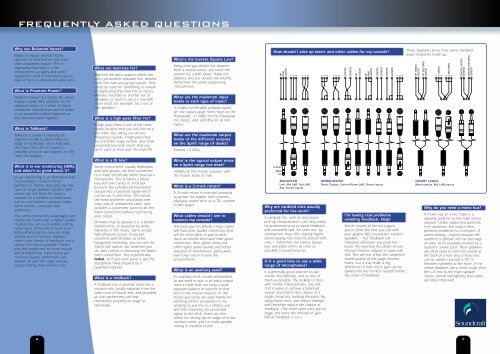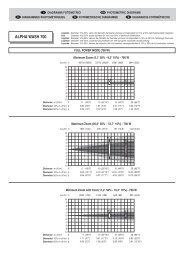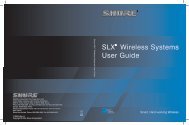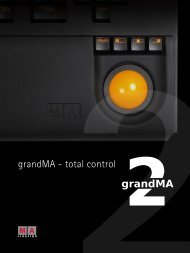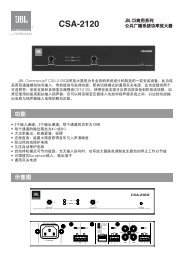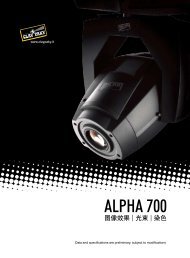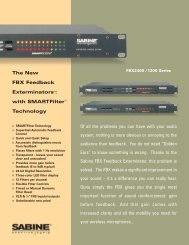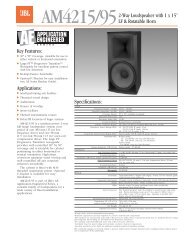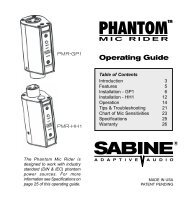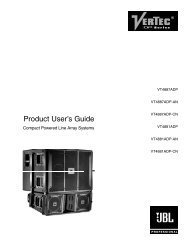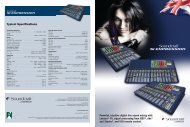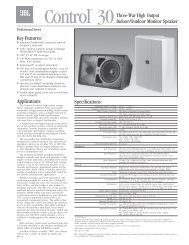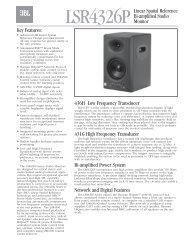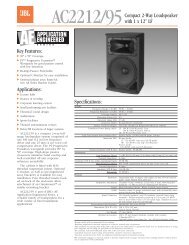LIVE RANGE BROCHURE LIVE MIXING CONSOLES ... - Soundcraft
LIVE RANGE BROCHURE LIVE MIXING CONSOLES ... - Soundcraft
LIVE RANGE BROCHURE LIVE MIXING CONSOLES ... - Soundcraft
Create successful ePaper yourself
Turn your PDF publications into a flip-book with our unique Google optimized e-Paper software.
FREQUENTLY ASKED QUESTIONS<br />
Why use Balanced Inputs?<br />
Balanced inputs provide better<br />
rejection of interference and noise<br />
than unbalanced inputs. This is<br />
especially important in a live<br />
environment, as lights and other<br />
equipment tend to introduce a good<br />
deal of hum in unbalanced cable runs.<br />
What is Phantom Power?<br />
Phantom power is a simple DC power<br />
supply, usually 48V, available via the<br />
balanced inputs of a mixer. It allows<br />
condenser microphones and DI boxes<br />
to be powered without batteries or<br />
any external power supplies.<br />
What is Talkback?<br />
Talkback is a way of allowing an<br />
engineer to talk to performers onstage<br />
or backstage, via a dedicated<br />
mic input that can be routed to<br />
(usually) group or aux outputs, or the<br />
main mix outputs.<br />
What is in-ear monitoring (IEM),<br />
and what’s so good about it?<br />
In-ear monitoring is an alternative way<br />
of providing a monitor mix to<br />
performers. Rather than play the mix<br />
over on-stage speaker cabinets, IEM<br />
carries the mix from the mixer’s<br />
outputs via a wireless or hard-wired<br />
link to a performer’s compact bodyworn<br />
receiver, complete with<br />
earphones.<br />
This offers several key advantages over<br />
traditional monitoring: a higher quality<br />
monitor mix can be provided, and by<br />
reducing or (if the whole band is on<br />
IEM) eliminating the extra on-stage<br />
volume due to monitor speakers,<br />
there’s less chance of feedback and a<br />
better FOH mix is possible. There’s<br />
also less equipment to move around,<br />
and provided that transmitters are<br />
correctly placed, performers can<br />
wander all over the stage without<br />
compromising their monitor mix.<br />
What are matrices for?<br />
Matrices are extra outputs which can<br />
carry yet another separate mix, derived<br />
from the main and group busses. They<br />
could be used for something as simple<br />
as duplicating the main mix to feed a<br />
MiniDisc recorder or another set of<br />
speakers, or used to carry a mix with<br />
more vocal, for example, for a set of<br />
rear speakers.<br />
What is a high-pass filter for?<br />
A high-pass filter is one of the most<br />
useful facilities that you will find on a<br />
live mixer. By cutting out all lowfrequency<br />
sounds, a high-pass filter<br />
can eliminate stage rumble and other<br />
unwanted low-end ‘mush’ that you<br />
don’t want to hear over the main PA.<br />
What is a DI box?<br />
Some instruments, usually keyboards<br />
and bass guitars, are best connected<br />
to a mixer electrically rather than via a<br />
microphone. This is where a Direct<br />
Injection box comes in. A DI box<br />
converts the unbalanced instrument<br />
output into a balanced signal which<br />
can be run to the mixer. This avoids<br />
the noise problems associated with<br />
long runs of unbalanced cable, and<br />
provides a convenient point to lift the<br />
earth connection without butchering<br />
your cables.<br />
DI boxes may be passive (i.e. a simple<br />
transformer), or powered by either<br />
batteries or the mains. Some accept<br />
48V phantom power. If you get<br />
problems with DI boxes or other<br />
equipment humming, you can use the<br />
‘Earth Lift’ switch; but whatever you<br />
do, don’t resort to removing the Mains<br />
earth connection. This is potentially<br />
lethal, so if you can’t solve it, get the<br />
equipment fixed properly by a<br />
qualified engineer.<br />
What is a foldback?<br />
A foldback mix is another name for a<br />
monitor mix, totally separate from the<br />
main front-of-house mix, and provided<br />
so that performers can hear<br />
themselves properly on stage or<br />
backstage.<br />
What’s the Inverse Square Law?<br />
Every time you double the distance<br />
from a sound source, you halve the<br />
volume (ie. a 6dB drop). Halve the<br />
distance and you double the volume.<br />
Remember this when positioning<br />
microphones.<br />
What are the maximum input<br />
levels to each type of input?<br />
+22dBu for UltraMic preamp inputs<br />
(ie. mic inputs apart from those on the<br />
Powerpad), +14dBu for the Powerpad<br />
mic inputs, and +30dBu for all line<br />
inputs.<br />
What are the maximum output<br />
levels of the different outputs<br />
on the Spirit range of desks?<br />
Around +21dBu.<br />
What is the typical output noise<br />
on a Spirit range live desk?<br />
-80dBu at the master outputs, with<br />
the master fader at max.<br />
What is a 2-track return?<br />
A 2-track return is intended primarily<br />
to accept the output from a stereo<br />
playback source such as a CD, cassette<br />
or MD player.<br />
What cables should I use to<br />
connect my console?<br />
The best you can afford! Cheap cables<br />
will have poor quality connectors that<br />
will be more likely to give trouble<br />
(such as crackle and buzz) than good<br />
connectors. Also, good cables will<br />
offer higher audio quality and better<br />
rejection of interference, particularly<br />
over long runs in hostile live<br />
environments.<br />
What is an auxiliary send?<br />
An auxiliary send, usually abbreviated<br />
to aux send or aux, is an extra output<br />
from a mixer that can carry a quite<br />
separate balance of sources to that<br />
sent to the master outputs. In the<br />
studio aux sends are used mainly for<br />
patching effects processors in, by<br />
sending an aux mix to a effects unit<br />
and then returning the processed<br />
signal to the desk. Auxes are also<br />
useful for setting up on-stage or in-ear<br />
monitor mixes, and for multi-speaker<br />
mixing in installed sound.<br />
How should I wire up insert and other cables for my console?<br />
BALANCED<br />
Line, Mix L&R, Sub L&R,<br />
Aux, Stereo Inputs<br />
Why are cardioid mics usually<br />
preferred for live work?<br />
A cardioid mic, with its directional<br />
pick-up characteristics, can fairly easily<br />
be positioned so as to avoid feedback<br />
and unwanted spill. An omni mic, by<br />
comparison, may offer slightly higher<br />
sound quality, but must be placed with<br />
care – remember the inverse square<br />
law, and place omnis as close as<br />
possible to sound sources.<br />
Is it a good idea to use a wide<br />
range of microphones?<br />
It is generally good practice to use<br />
similar microphones, and as few of<br />
them as possible. By sticking to mics<br />
with similar characteristics, you will<br />
find it easier to achieve a balanced<br />
sound, and there’s less chance of a<br />
single cheap mic spoiling the party. By<br />
using fewer mics, you reduce leakage,<br />
and therefore reduce the chance of<br />
feedback. (The more open mics are on<br />
stage, the more the amount of gain<br />
before feedback is cut.)<br />
UNBALANCED<br />
Direct Output, Control Room L&R, Stereo Inputs<br />
I’m having real problems<br />
avoiding feedback. Help!<br />
You’ve moved all the mics again,<br />
you’ve done the best you can with<br />
your graphic EQ, moved the monitor<br />
speakers – but feedback still<br />
threatens whenever you push the<br />
levels. Try reversing the phase of one<br />
of your monitor outputs to deal with<br />
this. This will not affect the subjective<br />
sound quality of the stage monitor<br />
mixes, but it may make a big<br />
difference to how much gain can be<br />
dialled into the monitor system before<br />
the onset of feedback.<br />
These diagrams show how some standard<br />
leads should be made up.<br />
INSERT LEADS<br />
Mono Inserts, Mix L&R Inserts<br />
Why do you need a mono bus?<br />
A mono bus on a live mixer is a<br />
valuable addition to the main stereo<br />
outputs. Unlike studio and domestic<br />
hi-fi situations, live sound often<br />
presents problems for a simple L-R<br />
stereo mixing – mainly because the<br />
audience is spread over far too large<br />
an area to be properly covered by a<br />
system’s ‘sweet spot’. Rear speakers<br />
are often used to reinforce sound at<br />
the back of a hall, and a mono bus<br />
can be used to provide a ‘fill’ in<br />
between speakers at the front. If the<br />
centre speakers carry more vocals than<br />
the L-R mix to the main speaker<br />
stacks, overall intelligibility and clarity<br />
are often improved.<br />
8<br />
9


